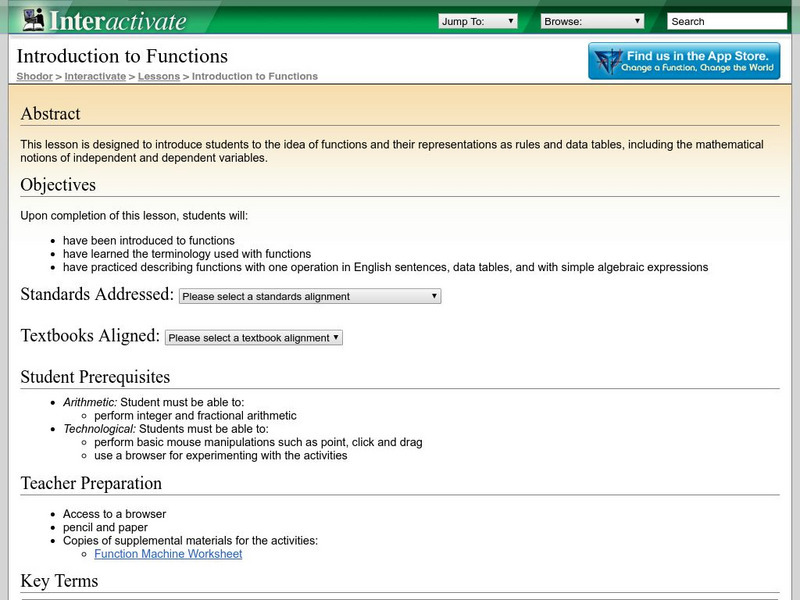Curated OER
What's My Function?
Fifth graders utilize input/output tables to help them solve algebraic equations. They incorporate patterns, number sequences and relations to represent and analyze mathematical problems and number relationships using algebraic symbols.
Mathematics Assessment Project
Building and Solving Linear Equations
Young scholars write and solve linear equations in one variable based on descriptions of the operations that are applied to the unknown variable in an algebra machine. They then create their own problems for classmates to solve.
Curated OER
Composition of Functions
Young scholars solve composition of functions. For this algebra lesson, students find the sum, difference and product of functions. They find the inverse of a function.
Curated OER
The Function Box
Students explore arithmetic and numerical patterns. After observing a teacher created function box, students describe a pattern and predict what will "come out" of the function box. They explore patterns such as geometric shapes,...
Curated OER
Applications of Quadratic Functions
In this math learning exercise, students investigate the quadratic functions. They solve the word problems while writing the new algebra expressions.
Curated OER
Linear Functions
Fifth graders investigate the concept of a function in relationship to how it is used. The concept is essential for the future study of Algebra. They apply the use of patterns with its relationship to functions.
Curated OER
Function Tables
Students identify function using tables of data. In this algebra lesson, students create a tale of point and plot on a coordinate plane. They analyze the graph as being a function or not.
Inside Mathematics
Quadratic (2009)
Functions require an input in order to get an output, which explains why the answer always has at least two parts. After only three multi-part questions, the teacher can analyze pupils' strengths and weaknesses when it comes to...
Curated OER
Model and Solve Algebraic Equations
Examine multiple ways to solve algebraic equations. Pupils will generate a problem solving strategy that addresses the prompt given by the teacher. They will then share their problem solving strategy with the class. Graphic organizers,...
Curated OER
The Function Box
Students look around classroom and identify any patterns they see, describe patterns and explain why they are patterns, use pencil to demonstrate arithmetic patterns by tapping, practice predicting patterns by using Function Box, and...
Curated OER
Introduction To Functions
Students define a functions and solve problems using functions. In this algebra lesson, students differentiate functions from non-functions. They differentiate between polynomials of higher degrees.
Curated OER
Making Connections
Eighth graders investigate the input/output model for building function tables. From the data, 8th graders connect tables, graphs, function rules, and equations in one variable. They work backwards to determine function rules for given...
National Security Agency
Growing Patterns: Practical Pattern Problems
Your learners explore growing patterns by describing, extending, creating, and evaluating practical pattern problems in this three-day collaborative unit. Beginning with concrete patterns and function tables to extend and...
Curated OER
Addends with Spiffy
Students solve single variable equations. For this missing addend lesson, students solve problems with missing addends. Students create a function box to help study numerical reasoning.
Curated OER
Rules of Sign Change
Students manipulate negative and positive numbers. In this integers instructional activity, students move through three activities exploring negative and positive whole numbers. A number line, cardboard function representation, and...
EngageNY
Why Were Logarithms Developed?
Show your class how people calculated complex math problems in the old days. Scholars take a trip back to the days without calculators in the 15th installment of a 35-part module. They use logarithms to determine products of numbers and...
Curated OER
The Beauty of Number Patterns
Teaching your child about patterns can be a fun and motivating experience.
NASA
What's the Frequency, Roy G. Biv?
While all light travels at the same speed, each color in the visible light spectrum contains a different wavelength and frequency. Scholars determine the relationship between frequency and wavelength as they complete the activity. They...
Virginia Department of Education
Spring Fling Carnival
Think critically — and linearly by applying linear equations to solve real-world problems. Young mathematicians write equations to model the profit on popcorn and cotton candy at a carnival and solve problems using these equations.
Shodor Education Foundation
Shodor Interactivate: Function Machine
Students investigate very simple functions by trying to guess the algebraic form from inputs and outputs.
Shodor Education Foundation
Shodor Interactivate: Linear Function Machine
An interactive "machine" allows you to see first hand how a function works. Enter several input values, receive the output values, and determine the algebraic function.
Annenberg Foundation
Annenberg Learner: Running a Function Machine
The connected machine is a single function that takes an input, runs it through the network inside and produces an output. You control a network of function machines along with the input and the operation performed by each machine to...
Alabama Learning Exchange
Alex: Function Machine
During this lesson, eighth grade students will interpret the perimeter of a train of triangles, squares, trapezoids, or hexagons as a function (for each input, there will be exactly one output). Students will represent their data in a...
Shodor Education Foundation
Shodor Interactivate: Lesson: Introduction to Functions
Input numbers into the function machine and explore independent and dependent variables.






















